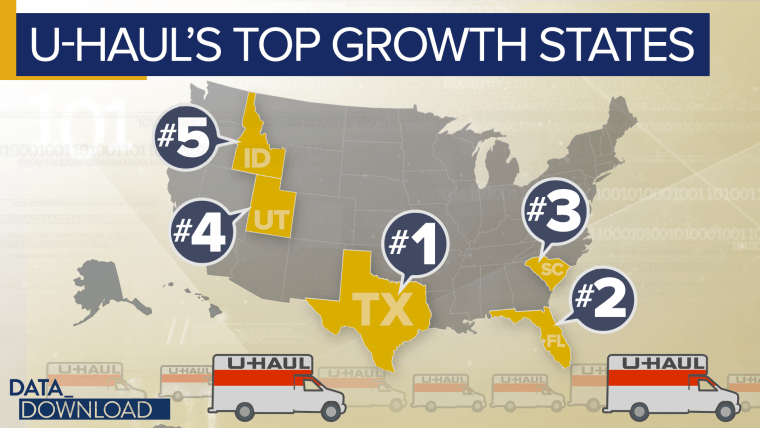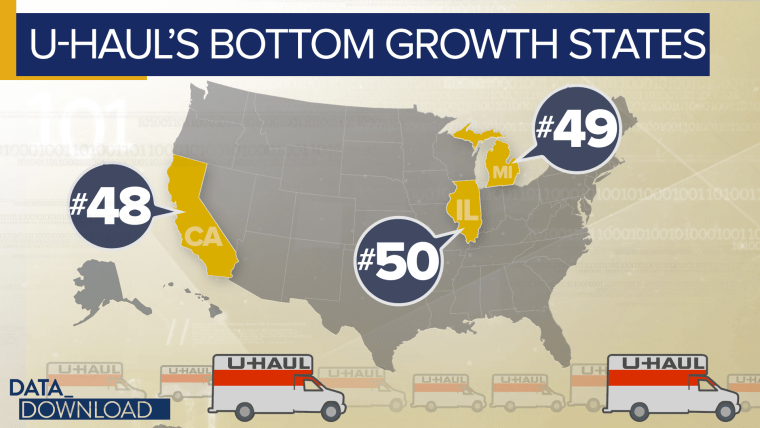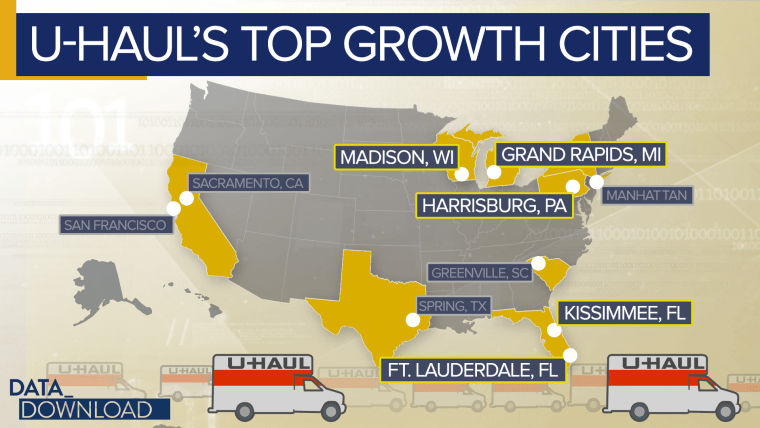WASHINGTON — Geography has become a crucial definer of American politics, as vote data suggest we are increasingly a nation of red communities and blue communities. And through that lens, new data from U-Haul offers a glimpse into 2018’s internal population migration and its potential electoral implications.
Every year the moving company lists its top moving destinations across the United States, gathered from more than 2 million one-way rental contracts at its 21,000 locations across the United States. And depending on how you view the numbers, 2018’s version had some good news for both Republicans and Democrats.
Looking at the numbers at the state-level, everything seems to be coming up crimson.

The top five states for incoming growth, using the U-Haul data, were all states that voted for President Donald Trump in 2016: Texas, Florida, South Carolina, Utah and Idaho. On that list are some states that were solidly behind the president — Trump won Idaho by 32 percentage points — but also some where the fight was much closer, such as always-pivotal Florida.
If you are a Republican, that may give you some comfort as a tough re-election fight draws nearer. And making you feel even better may be the bottom three states, places that all saw net-negative migrations.

California, Illinois and Michigan all saw declines. That’s two reliable Democratic states on Election Day and one crucial battleground that has a long history of voting Democratic that are all seeing more U-Haul trucks moving out than pulling in.
So on the most basic level, it looks like Red America is drawing people in and Blue America is sending people away.
But zoom down to the city-level in the U-Haul data, and the numbers get a bit more complicated and seem to take on a bit of a blue tint. Consider the top 10 cities for growth in the moving company’s numbers.

Five of those cities look like blue islands in battleground states that voted for Donald Trump in 2016: Harrisburg, Grand Rapids, Fort Lauderdale, Madison and Kissimmee. The vote in each municipality went in the opposite direction of the state’s presidential vote. And the final tally in those four states wound up close. In Pennsylvania, Michigan, Florida and Wisconsin, Trump’s margin of victory was less than 1.5 percentage points.
In other words, a few thousand more Democratic votes in those cities could make a big difference. Trump won three states — Michigan, Pennsylvania and Wisconsin — by a total of about 78,000 votes, and without those states he would not have captured the White House.
To be clear, there are a lot of caveats with this data. The political leanings of these movers are not readily knowable. But the U-Haul numbers support some larger trends that are apparent in other migration and vote data.
Yes, the population in the Electoral College’s Republican red states is growing, particularly in the Mountain West. But urban areas around the country are becoming more densely populated and as they do, they are growing more Democratic. Those two realities can have contradictory impacts.
Consider another state that has seen a lot of incoming migration in the past few decades: Colorado. For years it was reliably Republican. From 1968 to 2004 it voted for the GOP nominee in nine out of 10 presidential elections and was the definition of a fast-growing red state.
But driving Colorado’s population influx was the very blue metro area around Denver, which saw skyrocketing growth. That area came to define the state and change it. Since 2008, Colorado has sided with the Democratic presidential nominee in every election.